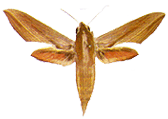|
Hippotion echeclus Boisduval
Choerocampa echeclus Boisduval, 1875,
Hist. nat. Insects. Spec. Gen. Lep., 1: 233.
Hippotion echeclus Boisduval; Rothschild & Jordan, 1903: 754.
|

Hippotion echeclus ♂
(.83 natural size)
|
Diagnosis. This and the next two species belong to a complex of four
easily confused taxa, all of which are present in South-east Asia. Only
three are known to occur in Borneo. All have reddish pink hindwings with a
narrow brown border, and rather similar obliquely handed forewings. They
can be distinguished on features of the harpe in the male genitalia; all
four species are keyed and their genitalia illustrated by Dupont &
Roepke (1941).
H. echeclus has paler, more elongate forewings than boerhaviae, a
straighter forewing margin and a diagnostic black suffusion at the base of
the hindwing. The abdomen is distinctly paler than the thorax, striped
with pale gold more extensively than in other species; in the latter the
thorax and abdomen are more concolorous. The harpe is globose with an
apicular thornlike process as in rosetta and boerhaviae (rafflesi Butler
has a more rectangular process, darker red hindwings without a basal dark
patch, and more strongly marked forewings), but generally more elongate.
Geographical range. India to Philippines, Sulawesi and Sumba.
Habitat preference. This species has only been taken in agricultural and
other open habitats in the lowlands.
Biology. The larva has been described by Bell & Scott (1937) and Dupont & Roepke (1941). The former only refer to a
green form but the latter also describe a greyish brown form. Both have
pale yellow dorsolateral bands that are broken by ocellar markings on A1
to A3. The nucleus of the first ocellus in the green form is black, ringed
part yellow, part brown; the posterior ocelli are bright yellow, ringed
pale brown. Other abdominal segments have dark green or dark brown spots.
The horn is brown, pink-tipped.
Host-plants recorded (Bell & Scott, 1937; Dupont & Roepke, 1941;
Pholboon, 1965) are: Boerhavia (Nyctaginaceae); Sesamum (Pedaliaceae);
Monochoria (Pontederiaceae).
<<Back
>>Forward <<Return
to Contents page
|

